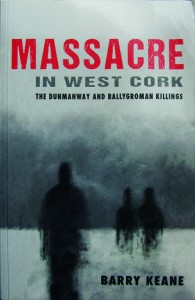Massacre in West Cork: the Dunmanway and Ballygorman killings
Published in Issue 3 (May/June 2014), Reviews, Volume 22BARRY KEANE
Mercier Press
£19.99
ISBN 9781781172032

The killing of thirteen Protestants in West Cork in April 1922—the ‘Ballygorman and Dunmanway massacre’—is one of the most disputed incidents in modern Irish history. On 26 April 1922, Michael O’Neill (a local IRA man) was shot dead by Herbert Woods during an arms raid on the farm of local loyalists—the Hornibrooks. Several hours later, Woods and Samuel and Thomas Hornibrook were kidnapped and killed, their bodies never recovered. In the days that followed, unknown assailants shot dead ten more Protestants in and around Dunmanway. While revenge accounts for the initial three killings, the later attacks are harder to explain. Barry Keane concentrates particularly on the possibility that the victims were members of a local ‘anti-Sinn Féin League’ or ‘Protestant Action Force’. There is plenty of evidence to suggest that such groups existed in some parts of Ireland but their membership is controversial. The late Peter Hart and Gerard Murphy argue that they were RIC men and British officers or agents. Meda Ryan suggests that the majority of those killed in April 1922 were members of clandestine loyalist groupings, spies whose names appeared on a list of ‘helpful citizens’ that was apparently left behind in Dunmanway by departing Auxiliaries and subsequently found by the IRA. Keane concludes that there is not enough evidence to say for sure either way, but describes the killings as ‘unauthorised and illegal’ and a ‘dark stain on the reputation of the Bandon IRA’. Keane’s own research into those who were targeted or attacked during the ‘massacre period’ but survived is particularly interesting. He gives a helpful appendix listing the victims, and suggests that ‘at least thirty individuals, mostly, but not exclusively, Protestant, were attacked’. The number targeted over such an extensive area suggests that the killing of O’Neill prompted a widespread breakdown of discipline within the West Cork IRA.
There are several good things about this book. Keane rightly dismisses the more outlandish theories put forward over the years. He accepts that the killings were carried out by the local anti-treaty IRA (not British agents) and acknowledges that there is no evidence to support John Regan’s more recently postulated theory that the April events were triggered by information gathered by the IRA from three British intelligence officers captured in Macroom on 26 April and killed. Keane tries to be fair-minded about victims and perpetrators alike, though his entirely uncritical use of the Bureau of Military History witness statements leads him to exaggerate the IRA’s intelligence capabilities. The book should have been proofread more carefully, and some sources are misconstrued. In a post-war lecture on Ireland about his intelligence sources, for instance, Lt Gen. A.E. Percival did not say that his ‘main sources of information were loyalist farmers and that he kept a six-inch map which identified the individual houses of those known to him on his office wall’. Percival actually described a map used to record both sympathetic and hostile local residents. He identified local loyalists, ‘especially those who are not afraid to tell him [the intelligence officer] what they know’, as one of several intelligence sources, along with captured documents, regular reports from a local IRA captain and anonymous letters.
Keane’s research is heavily indebted to Hart’s, though the author prefers to emphasis the points on which he disagrees with him. Hart is criticised for using ‘anonymous sources’ and for stating that sectarianism was a factor in the killings. At the same time, Keane’s book is less hypocritical than most of Hart’s critics when discussing the evidence that Ryan used to dispute Hart’s conclusions. He at least acknowledges that the whereabouts of the ‘Dunmanway find’ documents—on which Ryan’s hypothesis that the April 1922 victims were spies principally rests—have never come to light. It is not even clear from Ryan’s citations that she has actually seen them. Nevertheless, Keane goes too far in arguing (in a footnote) that ‘All oral history is expected to be deposited in a repository to be accepted as historical documents’. The more sources that are publicly accessible the better, but there is nothing wrong per se with using private collections of papers or un-archived interviews. Some of the best modern work on both the Irish revolutionary period and the ‘Northern troubles’ uses both, including Joost Augusteijn’s From public defiance to guerrilla warfare, David Fitzpatrick’s Politics and Irish life and Richard English’s Armed struggle. Indeed, if Keane’s criterion is applied to Ryan’s work, no one can rely on her books anymore. Her research is far more dependent generally on private collections (eighteen in her biography of Tom Barry) and inaccessible oral history interviews (her own) than Hart’s or any of the above. Ryan says that Tom Barry’s papers identify several of the April 1922 victims as spies, but these papers are also unavailable (I was recently refused access to them).
There are still many undisclosed sources relating to the 1919–23 period in Cork, including but not limited to several interviews that Hart either conducted himself or accessed. It is not fair, and it has never been fair, that the majority of Hart’s critics have focused almost exclusively on the lack of access to his sources when so much other material remains similarly inaccessible. Hart’s critics need to set a better example. Keane’s book is a first step in that direction.
















